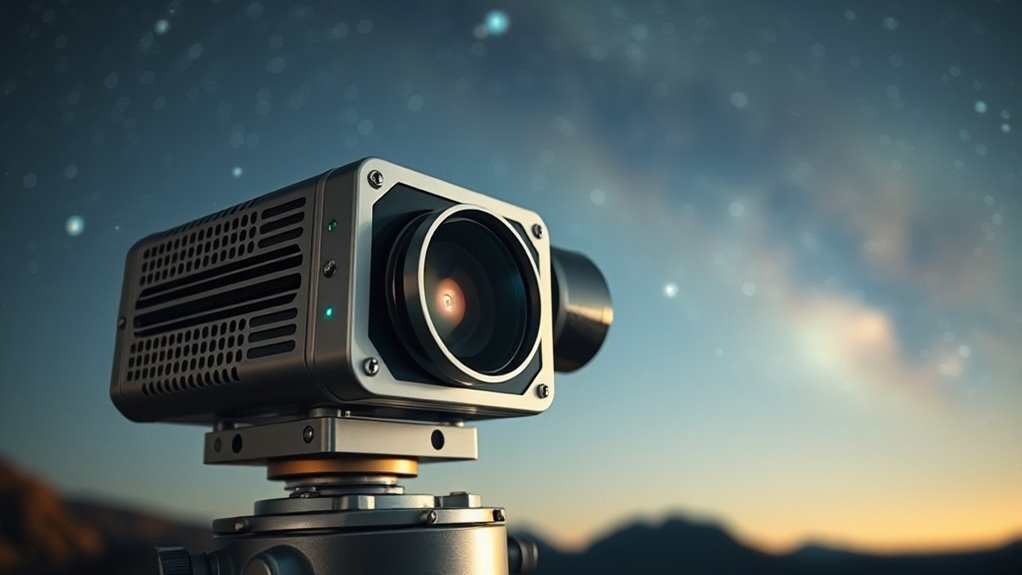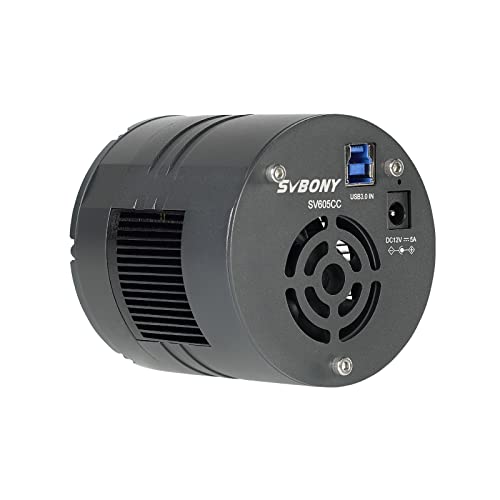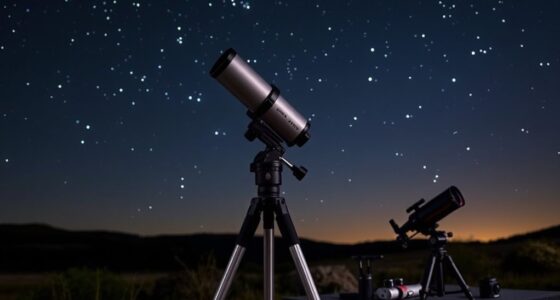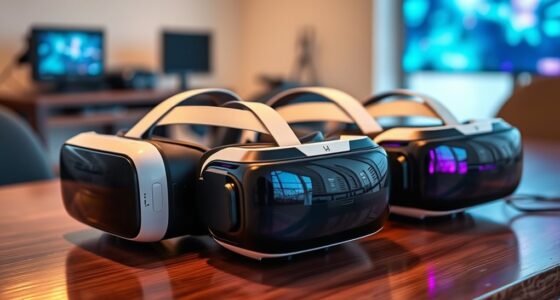If you’re looking for the top cooled CMOS astro cameras for clear deep sky shots in 2025, I recommend the SVBONY SV605CC and the Astromania SGCMOS series. The SV605CC offers a high-resolution sensor with efficient cooling for low noise, perfect for faint objects. The Astromania series also provides excellent sensitivity and robust housing with auto-guiding features. Keep in mind that choosing the right camera depends on your setup and budget—there’s plenty more to discover to optimize your astrophotography.
Key Takeaways
- Look for models with high-sensitivity sensors like IMX533 and high quantum efficiency for capturing faint deep sky objects.
- Prioritize cameras with efficient cooling systems (TEC or semiconductor) to minimize thermal noise during long exposures.
- Ensure compatibility with your existing setup through USB 3.0, auto-guiding ports, and support for protocols like ASCOM or WDM.
- Consider the resolution and pixel size to balance image detail, sensitivity, and field of view for deep sky astrophotography.
- Choose reputable brands like SVBONY or Astromania offering durable build, reliable cooling, and strong user reviews for clearer astrophotos.
SVBONY SV605CC Cooled Astrophotography Camera
The SVBONY SV605CC cooled astrophotography camera is an excellent choice for serious astronomers who want high-quality deep sky images with minimal noise. Its 9MP IMX533 color CMOS sensor delivers sharp, detailed shots with a 1-inch chip and 3.76μm pixels. The camera’s cooling system, which reduces temperatures by up to 30°C, minimizes thermal noise during long exposures. Compatible with fast mirror systems and short focus setups, it captures finer details of distant objects. Fast data transfer via USB 3.0 ensures smooth operation. Overall, the SV605CC provides reliable, high-resolution imaging perfect for deep sky, meteor, and panoramic astrophotography.
Best For: serious amateur astronomers and astrophotographers seeking high-resolution, low-noise deep sky images with reliable cooling and fast data transfer.
Pros:
- High 9MP resolution with IMX533 sensor for detailed imaging
- Efficient cooling system reduces thermal noise during long exposures
- USB 3.0 connectivity ensures quick data transfer and smooth operation
Cons:
- May require additional accessories for optimal setup and use
- Slightly higher price point compared to basic models
- Designed primarily for deep sky imaging, limiting versatility for other photography types
Astromania SGCMOS Series Telescope CMOS Camera
If you’re seeking a versatile camera that excels in auto-guiding and astrophotography, the Astromania SGCMOS Series Telescope CMOS Camera is an excellent choice. It features a high-sensitivity sensor with a fast frame rate and long exposure capabilities, perfect for capturing detailed images. Its aluminum CNC housing ensures durability, and the standard 1.25-inch interface allows easy attachment to telescopes. The built-in ST4 port simplifies auto-guiding, while the thermal design efficiently manages heat. Compatible with various lenses and software, it supports video preview, image processing, and raw data output, making it a flexible tool for deep-sky imaging.
Best For: amateur astronomers and astrophotographers seeking a versatile, high-sensitivity camera for auto-guiding and detailed deep-sky imaging.
Pros:
- High sensitivity sensor with fast frame rate and long exposure capabilities for detailed astrophotography
- Durable aluminum CNC housing with standard 1.25-inch interface and C-mount compatibility for versatile attachments
- Built-in ST4 auto guider port and thermal design for efficient auto-guiding and heat management
Cons:
- Requires compatible software and drivers, which may involve a learning curve for beginners
- Limited to USB 2.0 interface, which may be slower compared to newer USB standards
- Package weight and size may require careful handling during transport and setup
Factors to Consider When Choosing Cooled CMOS Astro Cameras for Deep Sky Imaging

When selecting a cooled CMOS astro camera for deep sky imaging, I focus on several key factors that can impact performance. I consider sensor sensitivity and quantum efficiency, as well as cooling effectiveness and noise reduction, to guarantee clear images. Compatibility with my equipment, software, and data management also plays a vital role in making the right choice.
Sensor Sensitivity and QE
Sensor sensitivity plays a crucial role in astrophotography because it determines how well a cooled CMOS camera can detect faint celestial objects. Higher sensitivity means the camera can pick up dim signals more effectively, which is essential for deep sky imaging. Quantum efficiency (QE) measures how many photons hitting the sensor are converted into electrons; a higher QE, like 80%, results in brighter, more detailed images. Cooling the sensor reduces thermal noise, helping maintain high sensitivity during long exposures. Pixel size also matters—larger pixels gather more light, boosting the signal-to-noise ratio in low-light conditions. Combining high sensitivity, elevated QE, and efficient cooling allows for capturing sharper, more detailed images of faint deep sky objects, making these factors critical when selecting a cooled CMOS astro camera.
Cooling Efficiency and Noise
Choosing a cooled CMOS astro camera hinges on its cooling system’s efficiency, as this directly influences noise reduction during long exposures. Effective cooling methods like TEC secondary refrigeration and double-layer semiconductor cooling are essential for lowering sensor temperatures by at least 20-30°C below ambient. This temperature drop greatly improves the signal-to-noise ratio, producing cleaner images with less grain and thermal artifacts. Cooler sensors reduce dark current, which is critical for deep sky imaging where long exposures are common. The better the cooling efficiency, the more consistent the noise suppression, enabling me to capture more detailed and accurate astrophotos. Proper thermal management not only enhances image quality but also guarantees reliable performance during extended imaging sessions.
Resolution and Pixel Size
Optimizing resolution and pixel size is essential for capturing detailed deep sky images with cooled CMOS astro cameras. Higher resolution allows me to capture more intricate details of celestial objects, which is critical for deep sky imaging. Smaller pixels, like 3.76μm, help resolve finer features but often require longer exposures to boost the signal-to-noise ratio, especially in faint objects. Conversely, larger pixels gather more light, enhancing sensitivity and reducing noise during low-light conditions. Striking the right balance between resolution and pixel size is key; too high a resolution with tiny pixels can demand advanced tracking and processing. Additionally, the combination influences the field of view—higher resolution sensors produce narrower views, focusing on fine details rather than broad sky coverage.
Compatibility With Equipment
Selecting a cooled CMOS astro camera that integrates smoothly with your existing equipment is essential for successful deep sky imaging. First, check that the camera’s mounting interfaces, like C-mount or 1.25-inch nosepieces, fit your telescope or accessories. Next, verify the connection type, such as USB 3.0 or USB 2.0, is compatible with your computer for reliable data transfer. It’s also important to confirm that the auto-guiding port (e.g., ST4) works with your guiding mount or software, enabling precise tracking during long exposures. Additionally, confirm that the sensor size and resolution match your telescope’s focal length and imaging goals to optimize field of view and detail. Lastly, choose a camera supporting standard astrophotography software and drivers like ASCOM or WDM for seamless control and integration.
Software and Data Handling
When considering a cooled CMOS astro camera, paying attention to its software and data handling capabilities can make a significant difference in your imaging results. I look for compatibility with my preferred software, like ASCOM or WDM drivers, to guarantee smooth control and data management. High-resolution image and video capture with raw data output are vital for detailed post-processing. Features such as dark field correction and long exposure support help produce clearer, more accurate images. I also check that the data transfer interface, like USB 3.0, provides fast, stable transfers for large files during long exposures. Additionally, seamless integration of auto-guiding and multi-camera control simplifies the workflow, saving time and reducing errors in deep sky imaging.
Power and Connectivity
Are you confident that your cooled CMOS astro camera‘s power and connectivity meet the demands of deep sky imaging? Ensuring compatible power requirements, like 5V or 12V DC, is essential for reliable cooling and sensor operation. I always check that my camera offers robust connectivity options, such as USB 3.0 or higher, for quick data transfers during high-resolution sessions. Auto-guiding ports, like ST4, are critical for seamless integration with guiding systems, reducing tracking errors. I also consider my power sources, especially for remote setups, making sure the camera’s consumption aligns with my available power. Finally, support for standard data protocols like ASCOM or WDM guarantees compatibility with my imaging software, streamlining automation and workflow. Power and connectivity are foundational for successful deep sky imaging.
Cost and Budget Balance
Balancing cost and features is key when choosing a cooled CMOS astro camera for deep sky imaging. Prices vary widely, so it’s crucial to match the camera’s capabilities with your budget to avoid overspending on unnecessary features. High-end models with advanced cooling systems and high-resolution sensors tend to be expensive and may be out of reach for beginners or casual astronomers. Budget-friendly options often have simpler cooling and lower sensitivity, which can limit deep sky imaging performance. Investing in a camera that offers a good balance of cooling efficiency and sensor quality can considerably improve image results without breaking the bank. Also, consider long-term costs like software, accessories, and maintenance to ensure your total investment stays within your financial plan.
Frequently Asked Questions
How Do Cooled CMOS Cameras Compare to CCD Options for Astrophotography?
Cooled CMOS cameras offer several advantages over CCDs for astrophotography. They’re generally more affordable, lighter, and have faster readout speeds, which means I can capture images more quickly. Their improved sensitivity and lower noise levels in recent models make them excellent for deep sky imaging. While CCDs still deliver exceptional image quality, CMOS cameras now provide a more cost-effective and versatile option, especially with modern cooling technology.
What Software Is Best for Processing Images From Cooled CMOS Astro Cameras?
I find that software like SharpCap and Sequence Generator Pro are excellent for processing images from cooled CMOS astro cameras. They offer user-friendly interfaces and powerful tools for stacking, calibration, and image enhancement. PixInsight is also a top choice for detailed post-processing, especially for deep sky objects. I recommend trying out a few to see which fits your workflow best, as each has unique features to improve your astrophotography results.
Can Cooled CMOS Cameras Be Used With Both Amateur and Professional Telescopes?
Ever wondered if cooled CMOS cameras are versatile enough for all telescopes? Absolutely! I’ve used mine with both amateur and professional setups, and they work seamlessly. Their adaptable design makes them a popular choice across different skill levels and equipment types. Whether you’re using a small beginner scope or a high-end observatory system, cooled CMOS cameras can elevate your astrophotography experience, capturing stunning deep sky images with ease.
What Is the Typical Lifespan of a Cooled CMOS Sensor Under Regular Use?
A cooled CMOS sensor typically lasts around 5 to 10 years with regular use, but this can vary depending on how often it’s used and maintained. I’ve found that proper care, like avoiding dust and humidity, helps prolong its lifespan. Regular calibration and gentle handling also prevent damage. Ultimately, staying attentive to signs of wear ensures you get the most out of your camera for years to come.
Are There Specific Cooling Methods That Improve Image Quality More Effectively?
Imagine a chilly mountain breeze wrapping around your camera, pulling heat away like a icy river flowing from a glacier. Active cooling methods, like thermoelectric coolers (TECs), are most effective—they actively lower sensor temps, reducing noise and enhancing image clarity. Precise temperature regulation, often with stable set points, guarantees your shots stay crisp and clear, even during long exposures. That’s how top astro cameras deliver stellar, detailed images.
Conclusion
Choosing the right cooled CMOS astro camera is like planting a seed for your cosmic garden; with the right tools, your images will bloom with clarity and detail. Whether you prefer the SVBONY SV605CC’s reliability or the versatility of the Astromania SGCMOS, remember that thoughtful selection nurtures your astrophotography journey. With patience and the right equipment, your deep sky masterpieces will shine brighter than ever, turning your night sky dreams into stunning reality.












